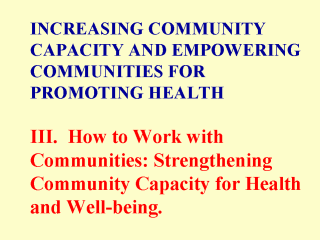| front |1 |2 |3 |4 |5 |6 |7
|8 |9 |10 |11 |12 |13 |14 |15 |16 |17 |18 |19 |20 |review |
 |
Did you see the Part I
and the Part II of this lecure? The mechanisms for strengthening communities are based always on the basic principles of respect for community values, knowledge, culture and decisions. The input of community leadership is essential to the whole process, and cannot be left exclusively to the technical staff. There is an overwhelming amount of literature on the subject of community participation, which can provide a great deal of useful and practical approaches and skills to develop community participatory processes in health. In this section we will briefly summarize some of the mechanisms and practices that facilitate CC building to achieve broad health objectives. Ultimately what is important is that communities acquire the skills to negotiate health matters and participate actively in decision-making processes. As it was already mentioned, community participation cannot occur in a vacuum, it is nourished by common problems and issues that affect people's lives This is the key for "how" to make communities get involved and develop their own capacity. Whatever techniques (e.g., focus groups, Delphi, consensus-development, participatory planning, logic- framework, etc.) are used to stimulate community participation, the focus to be maintained is the assessment of the situation and prioritization of needs and problems made by the citizens . The exercise of identification of problems and needs is the best starting point for CC building, and the goal is to have the participation of those who have never had the opportunity of being heard. Health administrators, leaders and politicians should listen to the problems identified by the community in order to gain the trust and confidence of the communities. |
| front |1 |2 |3 |4 |5 |6 |7
|8 |9 |10 |11 |12 |13 |14 |15 |16 |17 |18 |19 |20 |review |